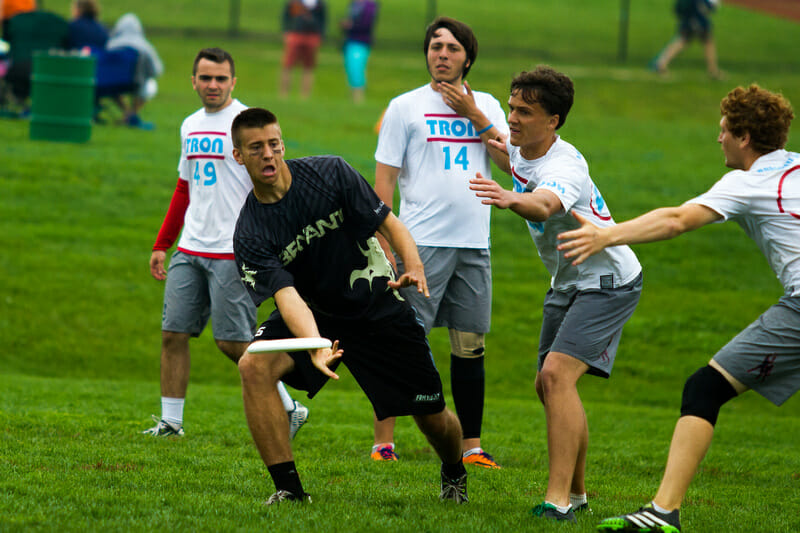The wind can affect how we view and value parts of the field.
September 21, 2021 by in Opinion with 0 comments

Tuesday Tips are presented by Spin Ultimate; all opinions are those of the author. Please support the brands that make Ultiworld possible and shop at Spin Ultimate!
A standard ultimate field is a 110 yards by 40 yards and there is something comforting about the familiarity and uniformity of it. The best players in the world and a brand new teenaged player interact with it the same way.
But what if the field weren’t always the same? What if the field had an incline across its width, with one sideline down the hill and the other side up it? It would change the way your team valued locations on the field.
Now this isn’t literal — hopefully. If it is, this article won’t be helpful for you in dealing with that situation. But it is a way to view the field when it is affected by wind. That reshaping changes things, and if your team isn’t reacting, you’re giving away advantage to your opponent.
Understanding High Side and Low Side
When these conditions arise, I refer to the one side of the field as the “high side” — the upwind side — and the other as the “low side,” found downwind. Like a ball rolls down a hill, the disc is going to want to go to the low side, and it will be harder to get uphill to the high side. Even in a game with a wind blowing parallel to the sidelines, there’s often a side of the field the disc is going to tends towards. In a crosswind, this dynamic will be even more pronounced.
Throwers need to calibrate appropriately and receivers can read the disc more effectively knowing where the the wind is going to the push the disc.
Avoid the Trap Against Zones
Since this context is almost always wind-induced, it is common to face zones when in a high side/low side situation. The stronger the push to the low side, the more compressed the field will feel, and the more effective the zone defense will become. The disc will want to move to the low side — floaty throws will travel that way, and throws in that direction will be safer and easier to execute.
One of my most important tenets of quality zone offense is spreading the defense out by using the whole field. This means that reaching the high side of the field gains additional value and an offense should prioritize accessing it. In essence, when you have the disc on the high side, the field is wider — you can easily reach more parts of it — than when the disc is on the low side. If you need the low side, it’ll be easier to get the disc there but not to get it back. When the opportunity to get the high side presents itself, take advantage, even if the offense has to lose yards to do it.
One of my top ways to avoid the trap/low side is to choose short throws rather than wide throws towards the low side. Chiseling or crashing cuts can set up these opportunities to play small ball. The defense may even offer free yardage to the offense to tempt them to move onto the low side. Remember: there’s a reason they call it a “trap” zone. Don’t take the bait; try to keep the disc in the middle of the field and on the high side.
Set The Trap On The Offense
It turns out all of the things the defense might use on you can be effective for your defense, too! Reverse everything I said in the previous paragraph.
Now, we want to force the offense to play on a small field. We want to keep them from reaching the high side of the field and pin them on the low side. Our defense can give up yards in order to lure the offense to the low side. Many teams trap with the disc pretty close to the sideline, but if it is the low side, that trap range may extend further and further as the “incline” gets sharper.
It doesn’t have to be a zone or even a trap zone. The defense’s job gets easier the less field they have to defend. Adjust marks. Poach on the low side once the disc gets stuck there. Always force to the low side, so all the throws off the line have to fight upwind and all the hucks get pushed.
The Deep Game and Disc Reads
When throwing deep, it is advisable to give the offense space. Targeting a wide swath of field gives your receiver a chance to adjust and the thrower margin for error.
In the high-side/low-side scenario, the field becomes warped. When you throw from the high side, the field is very wide — it will push towards the low side and it is the furthest from that sideline when the disc goes up. That makes it far more effective to huck from the high side and give your offense a lot more room to work with. If you’re in a windy game turning into a battle of field position, being aggressive in your high side throwing choices can turn the tide.
In the same way, receivers should be anticipating the disc to move towards the low side. On a huck, they should turn over that shoulder. If a surprise throw pops up and turns floaty, it is probably going to the low side. The extra steps can be big difference makers in positioning and completion percentage.
And finally, tangentially related, pull from the high side.
Want more terms defined? Check out our ultimate frisbee glossary!